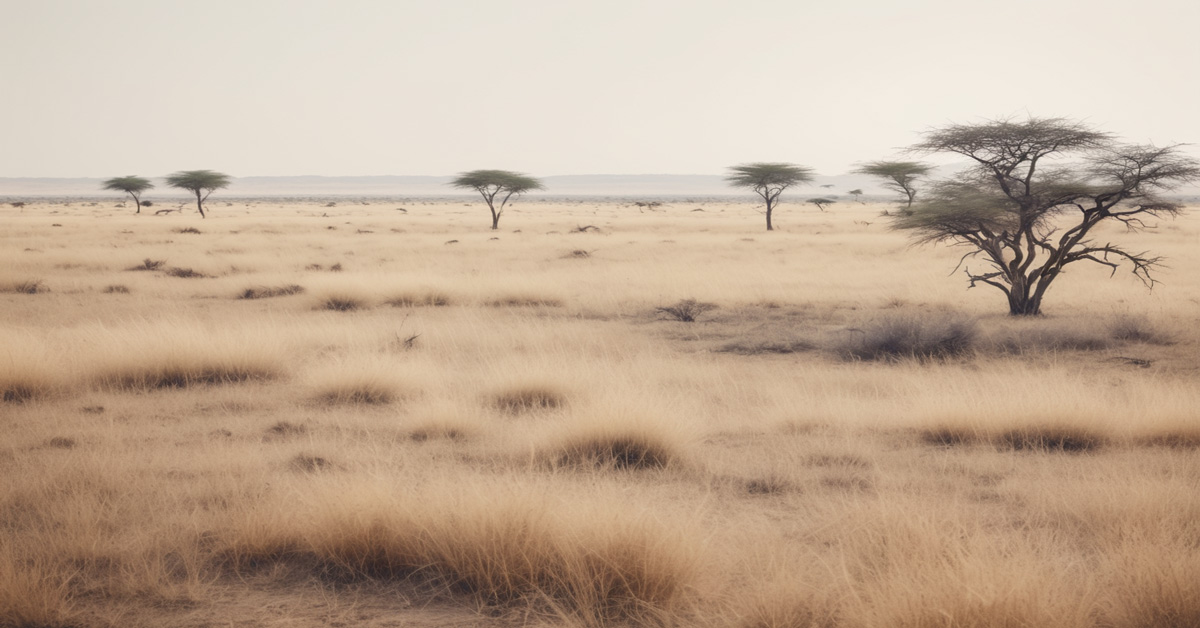
In the vast savannas of Africa, where dry spells can stretch for months, the language of survival is spoken among the grasses themselves. It’s a communication system that has evolved over thousands of years, enabling these resilient plants to not only survive but also thrive during droughts. But how do these grasses talk to each other? What messages do they convey? And how do they adapt their communication in times of limited water supply?
The Importance of Communication During Droughts
Communication is crucial for any organism, but it becomes especially vital during droughts. With limited water resources, grasses need to efficiently share information about water availability, nutrient levels, and potential threats. This communication ensures the survival of not just individual plants, but also the entire grassland ecosystem.
Grasses, being sessile organisms, cannot physically relocate to find water or escape predators. Instead, they rely on sophisticated communication strategies to navigate the challenges of their environment. By studying how they communicate during droughts, researchers hope to gain valuable insights for sustainable agriculture, conservation efforts, and adaptation to climate change.
Communication Methods Used by Grasses During Droughts
Grasses employ a variety of communication methods to exchange information and respond to changing conditions. One of the key ways they communicate is through chemical signaling. Through the release of volatile organic compounds, grasses can alert neighboring plants to water stress or potential threats. These chemical signals trigger physiological responses in nearby plants, such as the closure of stomata to conserve water.
But communication among grasses goes beyond chemical signaling. Recent research has uncovered the role of acoustic vibrations in their communication network. When grass leaves are stressed by drought, they emit faint clicking sounds that can be detected by nearby plants. This acoustic communication helps to coordinate responses and optimize resource allocation within the grassland community.
Chemical Signaling in Grasses
Chemical signalling is a fundamental aspect of grass communication during droughts. Through the release of specific compounds, grasses can convey messages about their water status, nutrient availability, and even the presence of herbivores. These chemical signals can travel through the air or be transmitted through the soil, allowing grasses to communicate over short and long distances.
One of the key players in chemical signalling is the hormone abscisic acid (ABA). When grasses experience water stress, they produce higher levels of ABA, which triggers a cascade of responses to conserve water and protect against drought-induced damage. ABA also acts as a signal to neighbouring plants, alerting them to the presence of water shortage and activating their own defence mechanisms.
In addition to ABA, grasses release other volatile organic compounds that serve as messengers in their communication network. These compounds can attract beneficial insects or repel herbivores, helping to maintain the delicate balance of the grassland ecosystem. The intricate chemical language of grasses ensures that vital information is transmitted efficiently, allowing plants to respond quickly and appropriately to changing conditions.
Physical Adaptations for Communication in Grasses
Grasses have evolved physical adaptations that facilitate communication during droughts. Their root systems, for example, play a crucial role in water uptake and resource sharing. In times of limited water supply, grasses can extend their roots deeper into the soil to access water reserves. Additionally, some grass species develop specialized root structures called mycorrhizae, which form symbiotic relationships with fungi. These fungal networks help to enhance nutrient uptake and can also serve as conduits for communication between plants.
Another fascinating adaptation of grasses is their ability to adjust their leaf angle in response to water availability. During droughts, grasses can change the orientation of their leaves to reduce water loss through transpiration. This physical response not only conserves water but also serves as a visual signal to neighboring plants, indicating the severity of water stress in the environment.
The Role of Underground Networks in Grass Communication
While above-ground communication methods are well-documented, recent research has shed light on the importance of underground networks in grass communication during droughts. Grasses form intricate networks of fungal hyphae, known as mycelium, which connect the roots of different plants. These mycelial networks facilitate the exchange of nutrients, water, and even information between plants.
Through these underground networks, grasses can communicate not only with their immediate neighbors but also with individuals further away. This allows for the rapid spread of information about water availability and potential threats throughout the grassland community. The interconnected nature of these networks highlights the collective response of grasses to drought and the importance of cooperation for survival.
Case Studies of Grass Communication During Droughts
Several fascinating case studies have provided insights into the communication strategies of grasses during droughts. In one study, researchers found that when a grass plant experienced water stress, it emitted chemical signals that triggered neighboring plants to close their stomata. This collective response helped to conserve water and maintain the overall health of the grassland ecosystem.
In another study, acoustic vibrations were found to play a role in grass communication during droughts. Researchers observed that when grass leaves were subjected to drought conditions, they produced clicking sounds that were detected by nearby plants. This acoustic communication allowed grasses to coordinate their responses and allocate resources effectively, enhancing their chances of survival during prolonged dry spells.
Implications for Agricultural Practices and Ecosystem Management
Understanding how grasses communicate during droughts has significant implications for agricultural practices and ecosystem management. By harnessing the knowledge of their communication strategies, researchers can develop innovative approaches to improve crop resilience to water stress. For example, by enhancing the release of specific signaling compounds, crops can communicate their water needs more effectively and trigger appropriate responses to conserve water.
In ecosystem management, knowing how grasses communicate during droughts can help inform conservation efforts. By preserving intact grassland ecosystems and promoting the establishment of mycorrhizal networks, we can support the communication and resilience of grasses in the face of changing climate conditions. This, in turn, contributes to the overall health and stability of the entire ecosystem.
Future Research and Advancements in Understanding Grass Communication
While significant progress has been made in understanding grass communication during droughts, there is still much to explore. Future research may delve deeper into the specific chemical compounds involved in signaling and their interactions with other organisms in the grassland ecosystem. Additionally, advancements in acoustic technology may allow for more precise detection and analysis of grass vibrations, providing further insights into their communication network.
As technology continues to advance, researchers may also uncover additional modes of communication in grasses, expanding our understanding of their complex language. By combining interdisciplinary approaches, including molecular biology, ecology, and acoustic studies, we can continue to unravel the mysteries of grass communication and its implications for the broader scientific community.
Conclusion: Appreciating the Complexity of Grass Communication During Droughts
In the vast savannas of Africa, grasses have developed a remarkable language of survival. Through chemical signaling, physical adaptations, and underground networks, they communicate vital information about water availability, nutrient levels, and potential threats. This complex communication system allows grasses to not only survive but also thrive during droughts, ensuring the resilience of the entire grassland ecosystem.
By understanding the language of the savanna, researchers can unlock new insights into sustainable agriculture, conservation efforts, and climate change adaptation. The study of grass communication during droughts offers a fascinating glimpse into the intricate web of interactions within ecosystems and reminds us of the remarkable adaptability of even the seemingly simple plants.
As we continue to uncover the secrets of grass communication, let us appreciate the resilience and interconnectedness of these extraordinary organisms. By listening to the language of the savanna, we can learn valuable lessons about survival, cooperation, and the power of effective communication in the face of adversity.




